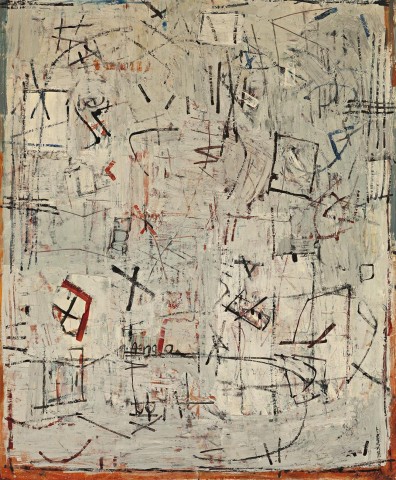CALLIGRAPHY ON AN ANCIENT TABLET, 1965
YVONNE AUDETTE
oil on plywood
57.5 x 47.5 cm
signed and dated lower right: Audette 65
signed verso: Audette
Mossgreen Gallery, Melbourne
Private collection, Melbourne, acquired from the above in October 2009
Yvonne Audette: Salon Exhibition, Mossgreen Gallery, Melbourne, 8 September – 3 October 2009 (label attached verso, as ‘Calligraphy on an Ancient Tablet, No. 2, 1960’)
Heathcote, C., Adams, B., Vaughan, G., & Grant, K., Yvonne Audette: Paintings and Drawings 1949 – 2003, Macmillan, Melbourne, 2003, p. 66 (illus. inverted, as ‘Calligraphy on an Ancient Tablet, No. 2, 1960’)
Yvonne Audette holds a unique position in twentieth century Australian art as one of the few female artists of her generation to have maintained a long and successful career working in an abstract mode. She left Australia to further her studies in late 1952, however unlike most of her peers, headed to New York, influenced by her American-born parents’ agreement to provide financial support if she went there rather than to Europe. While her training had been traditionally academic, with an emphasis on the figure, Audette’s first-hand exposure to the work of artists including Willem de Kooning (whose studio she visited in 1953), Robert Motherwell and Mark Tobey brought her face to face with the burgeoning New York School of Abstract Expressionist painting and she began to move confidently towards abstraction, developing a unique visual language that merged a lyrical use of colour with dextrous mark-making and the textural layering of line and abstract form.
After travelling in Europe Audette settled in Florence, establishing a studio there in 1955.1 Against the backdrop of Italy’s rich culture and artistic past, she was welcomed into a community of professional artists (including Arnaldo Pomodoro and Lucio Fontana) who encouraged her and provided an aspirational example. Focussed and determined, Audette worked hard, holding commercial exhibitions in Florence, Milan, Paris, Rome and London. A beautiful example of her work from the mid-1960s, Calligraphy on an Ancient Tablet, 1965 reflects the confidence of an artist who had reached creative maturity. Here we see her manipulating paint with a brush and palette knife, as well as the end of the brush (dragged through the paint), building up a richly tactile surface. Gestural marks play off against this texture, which is balanced against a restrained use of colour, where black, a deep tan, and shades of blue and grey are submerged and emerge through the pale toned ground. The Italian critic, Garibaldo Marussi, could well have been describing this painting when he wrote evocatively of Audette’s work, ‘images and sensations are decanted and purified, until no vestige of contact with the immediacy of objective reality remains. Recalled to the canvas surface, they have become delicate but nevertheless unfaltering images of wholly interior experience, the scanning of the syntax pronounced in moderate tones, without fanfare, almost fragile and yet strong, being endowed with intense evocative power.’2
While Audette’s work was rarely seen in Australia during her expatriate years, it has since been recognised for her important contribution to the history of twentieth century art in this country. Acquisitions by major public galleries were followed by a series of institutional exhibitions – Queensland Art Gallery (1999), Heide Museum of Modern Art (2000), National Gallery of Victoria (2008), Ian Potter Museum of Art (2009) and the Art Gallery of Ballarat (2016) – and the publication of a major monograph in 2003.
1. Audette lived in Florence until 1963, relocating to Milan before returning to Australia permanently in 1966.
2. Marussi, G., catalogue statement, Yvonne Audette, Galleria Schneider, Rome, 1965, quoted in James, B., ‘Yvonne Audette: The Later Years’, Heathcote, C., et. al., Yvonne Audette: Paintings and Drawings 1949-2003, Macmillan, Melbourne, 2003, p. 145
KIRSTY GRANT
